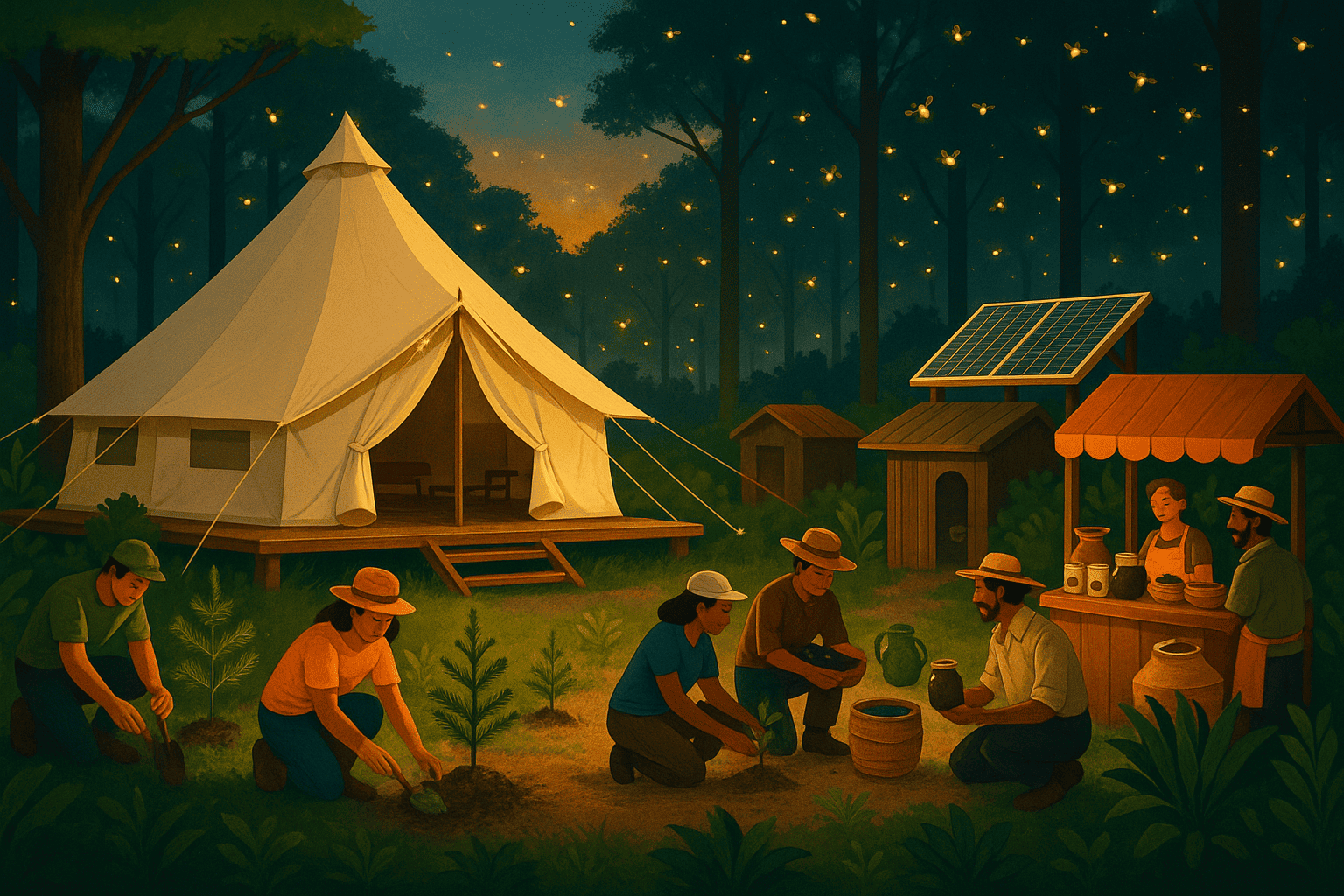Sustainable Tourism at Firefly Sanctuary MX
From Eco-Glamping to Community Impact
Tourism for Conservation is not a passing trend: at Firefly Sanctuary MX, we have transformed our passion for fireflies into a sustainable tourism project that benefits both the ecosystem and local communities. In this article, we’ll show how our eco-glamping practices, environmental certifications, and community partnerships turn every visit into a responsible act with high social value.
1. Our Four Pillars of Sustainability
- Habitat Protection
- Strict visitor limits on the trails to prevent soil compaction and disturbance of larvae—maximum 20 people per group.
- Clearly marked, designated trails designed to minimize impact on the forest understory.
- Continuous monitoring of firefly populations (authorized nightly surveys) to track reproduction rates.
- Eco-Glamping
- Safari-style canvas tents on wood platforms sourced from FSC-certified forests.
- Bathrooms with a biodigestion system that converts greywater into natural fertilizer for reforestation.
- Solar panels powering communal lighting and recharging flashlights.
- Biodegradable amenities: shampoo, soap, and recycled paper products.
- Waste Management & Circular Economy
- “Carry In – Carry Out” program: every visitor takes their trash and recyclables with them.
- Composting organic waste (peels, coffee grounds, food scraps) to enrich soil in local nurseries.
- Reusing hard plastics (bottles and packaging) in community art workshops to create crafts sold in the local shop.
- Recycling stations at check-in and the glamping area: separate bins for glass, plastic, paper, and organic waste.
- Social & Economic Impact
- Direct employment: certified guides, cooks, artisans, and hospitality staff are residents of Nanacamilpa, Huamantla, and neighboring communities.
- Investment in environmental education: school presentations, book donations, and conservation workshops for local youth.
- Partnerships with pulque cooperatives and coffee producers to offer their products on-site, boosting the local economy.
- Microcredits and training for local women to produce artisanal goods (honey, jams, ceramics) sold in the glamping eco-shop.
2. Eco-Glamping Octli: A Low-Impact Model
Glamping Octli is our “green” lodging option inside the Sanctuary. Key practices include:
- Bioclimatic Design:
- Strategic placement to leverage cool breezes and avoid air conditioning.
- White canvas covers that reflect sunlight and keep tents cool during the day.
- Sustainable Materials:
- Timber treated with natural oils, free of toxins.
- Mattresses and linens made from organic cotton and alpaca wool sourced from small family farms.
- Rustic furniture crafted by local carpenters using reclaimed wood.
- Water & Energy:
- Rainwater harvesting tanks to irrigate vegetation and for general cleaning.
- Solar panels on the community dining hall’s roof to power nighttime lighting and device charging.
- Meaningful Experiences:
- Firefly-watching workshops where guests help conduct nightly counts that feed our research database.
- Daytime guided walks to identify endemic flora, led by volunteer botanists.
- Pre-Hispanic temazcal ceremonies led by local shamans, combining holistic healing with ancestral respect for Mother Earth.
3. Certifications & Partnerships
- Local Environmental Certification (CAL)
- Awarded in 2023 after an audit of eco-friendly practices, waste management, and reforestation plans.
- Annual audits maintain standards: water quality, carbon footprint, and biodiversity indicators.
- Responsible Tourism Seal (CONANP)
- Recognizes the use of renewable energy and minimal impact on protected areas.
- Ensures that 80% of generated revenue is reinvested in conservation and education programs.
- Partnership with SEDARPA & Tlaxcala’s Environmental Secretariat
- Joint annual reforestation project: planting 5,000 native trees (ocote, pine, oak) in areas adjacent to the Sanctuary.
- Training for local communities in nursery management and constructing greenhouses for endangered species.
- Network of B Corporations & Environmental NGOs
- Collaboration with national NGOs (Pronatura, SEMARNAT) to implement insect and bird monitoring controls.
- Sharing best practices with other Firefly Sanctuaries in Latin America through annual ecotourism conferences.
4. Measurable Impact: Key Data
- 2024
- 5,000 visitors during the June–August season, with 15% annual growth.
- 4,200 guests stayed at Glamping Octli, using 60% less potable water compared to average urban lodging.
- 2,000 kg of compost produced and reused in community nurseries.
- 3,000 m² of reforestation completed in degraded areas around the Sanctuary.
5. How You Can Contribute
- Book through the official platform to ensure 100% of your payment funds conservation projects.
- Follow all responsible-watching guidelines: avoid unauthorized lighting and stay on the trail.
- Join the reforestation activities, held on two key weekends in July each year.
- Purchase eco-shop products (honey, coffee, artisanal goods) to stimulate local demand.
- Make voluntary donations to the Photinus palaciosi research fund to support climate-change impact studies.
6. Conclusion
At Firefly Sanctuary MX, sustainable tourism is the essence of our mission. From the design of Glamping Octli to community partnerships, every step aims to preserve the delicate firefly habitat and empower local populations. When you book your visit, you become an agent of conservation and part of a chain that supports Tlaxcala’s biodiversity.
